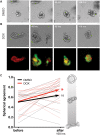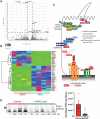GDNF drives rapid tubule morphogenesis in a novel 3D in vitro model for ADPKD
- PMID: 32513820
- PMCID: PMC7375472
- DOI: 10.1242/jcs.249557
GDNF drives rapid tubule morphogenesis in a novel 3D in vitro model for ADPKD
Abstract
Cystogenesis is a morphological consequence of numerous genetic diseases of the epithelium. In the kidney, the pathogenic mechanisms underlying the program of altered cell and tubule morphology are obscured by secondary effects of cyst expansion. Here, we developed a new 3D tubuloid system to isolate the rapid changes in protein localization and gene expression that correlate with altered cell and tubule morphology during cyst initiation. Mouse renal tubule fragments were pulsed with a cell differentiation cocktail including glial-derived neurotrophic factor (GDNF) to yield collecting duct-like tubuloid structures with appropriate polarity, primary cilia, and gene expression. Using the 3D tubuloid model with an inducible Pkd2 knockout system allowed the tracking of morphological, protein, and genetic changes during cyst formation. Within hours of inactivation of Pkd2 and loss of polycystin-2, we observed significant progression in tubuloid to cyst morphology that correlated with 35 differentially expressed genes, many related to cell junctions, matrix interactions, and cell morphology previously implicated in cystogenesis.This article has an associated First Person interview with the first author of the paper.
Keywords: 3D cell model; Collecting duct; Epithelia; Kidney; Polycystic kidney disease; Tubulogenesis.
© 2020. Published by The Company of Biologists Ltd.
Conflict of interest statement
Competing interestsThe authors declare no competing or financial interests.
Figures






References
-
- Antignac C., Calvet J. P., Germino G. G., Grantham J. J., Guay-Woodford L. M., Harris P. C., Hildebrandt F., Peters D. J. M., Somlo S., Torres V. E. et al. (2015). The future of polycystic kidney disease research—as seen by the 12 Kaplan Awardees. J. Am. Soc. Nephrol. 26, 2081 10.1681/ASN.2014121192 - DOI - PMC - PubMed
Publication types
MeSH terms
Substances
Grants and funding
LinkOut - more resources
Full Text Sources
Molecular Biology Databases
Miscellaneous

